So we have a system that will detect aircraft and shutter the laser.
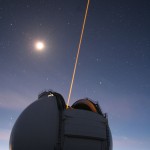
In theory TBAD will detect the TCAS transponder on an aircraft, turning off our AO Laser to avoid illuminating the aircraft. This work via means of a directional antenna mounted to the front of the telescope that is able to detect the 1090MHz TCAS transmissions from the aircraft. The system has been operational for the better part of a year, mounted to the Keck 2 telescope. It operates all the time, whether or not we are using the laser.
The problem is that there is very little air traffic over the summit, it is even more rare that a plane goes directly in front of the telescope while we are observing. It is these test cases we need to prove the system, an aircraft passing through where the laser would be. Though the first year of running the system we logged a total of one detection that would have resulted in a laser shutter event. We need more test cases if we are to prove to the FAA that the system works as designed.
We often detect aircraft that do not go through the antenna beam, as long as they are anywhere near the TBAD omni antenna will pick up the data packets from the TCAS transponders. This data contains a flight identifier, altitude and other data. While going through this data over the last year we discovered an odd aircraft, one that crossed the island multiple times in the day, an aircraft with a NASA flight number.
It took a little work to find contacts within NASA, but eventually we were talking to the right people. It helps that Keck is affiliated quite closely and is partially funded through NASA. The aircraft we had seen in our data is part of a project called UAVSAR.
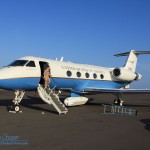
The UAVSAR aircraft flies a preplanned flight route, back and forth across the island. They must fly the plan with extraordinary accuracy to accomplish their mission, within a ten meter “tube” controlled by a precision autopilot. With their flight plan in-hand we were able to plan intercepts with equal precision, knowing exactly where to look. With a table of azimuth and elevation positions, I was able to point the telescope such that the aircraft would fly directly in front to create simulated laser shutter events. Thus I scheduled the Keck 2 telescope for three days of testing. It took a lot of planning, but we would be ready.
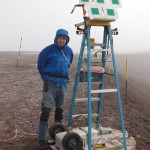
To arrive ahead of the NASA aircraft with time to setup our gear it was necessary to depart for the summit at 5am. Not my favorite time of day, but I must admit it was quite pretty. Sunrise caught us partway up the final switchbacks after a beautiful dawn featuring a bright Venus and crescent Moon.
After a promising start conditions turned for the worse, shortly after arrival a heavy fog enveloped the summit and quickly turned to snow. I was not going to be able to open the Keck 2 telescope in this. The outside team pressed on, setting up gear that quickly gathered a thin layer of ice. as did their jackets and gloves. The weather did break, for the most part, the fog retreating and the Sun returning for much of the day, at least until later in the afternoon. Best of all, there was little wind. It may be cold, but it is the wind that can turn conditions to misery very quickly.
Not that I had to worry much about the cold and wind. My seat was in the Keck 2 control room driving the telescope and dome. The control room is the warmest room on the summit. When the weather did clear I opened the dome and positioned the telescope for each intercept.
Steering the telescope around with the dome open and the Sun high in the sky is a nerve-wracking exercise. If the sunlight were to be focused by the mirrors it could easily damage something or start a fire in the dome. To prevent this I would move to positions only in the northern sky, between 330° and 50° azimuth. The dome was not fully open, the top shutter at most 60° open to provide a sunshade for the telescope. I would plan each move carefully, if the move called for a change from east to west I would move to true north first, no chance for the computer to choose a southerly path for the move. Each move was watched very carefully, with an e-stop button right beside me to bring everything to a halt if it moved the wrong way.
While we knew where to point, when was another issue. The aircraft crew messaged us when they took off from Kona each day, this gave us wheels-up time and the start to the schedule. Most days the times would slip a little between passes, and they occasionally needed to re-fly a pass. It was good enough that we could follow along each scheduled pass as our gear detected the aircraft, updating our times as we predicted the next pass and re-pointed our gear. After three days of tracking, we got pretty good at it.
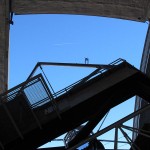
It was touch and go both days with the afternoon Sun heating the tropical air over Hilo and driving convected moisture to the summit. We almost did not get those last passes we had arranged. On Saturday, as we awaited the last pass, we could see the fog looming on the summit ridge half a mile away. I stood outside, with the dome radio control unit in my hand, watching the fog, ready to close the dome at any moment. It takes time to close those huge shutters, a minute or two even if I already had them as closed as possible, just exposing the TBAD antenna. Just after the aircraft passed the first wisps of fog swept by, my fingers mashing the controls for the shutters and the dome closing the last few feet.
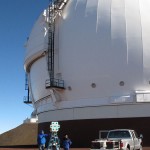
While the telescope mounted TBAD simulated a single laser shutter event, the outside unit could track the aircraft gathering much more data. We could adjust the detection settings and thresholds real-time. The telescope was restricted to northern passes to avoid the Sun. The outside unit had no such restriction and could use almost every pass over the island. The team mapped signal strength with respect to aspect ratio of the aircraft as it approached, flew overhead, and the receded from the receiver. We tested receiver saturation when the aircraft was close and minimal strength detections when the pass was distant.
We now have a pile of data detailing the performance of the system. Data that should be good enough to prove the system works and will accurately detect aircraft in the airspace over the telescope. We can prove our case to the FAA that we no longer need to station laser spotters outside through the night. Our night attendants can thaw out and we can continue to do great science with laser assisted adaptive optics.

